Foodstuff, Remedy, and Comfort | Family Life | Cafes
The cafe as a social crossroad and substitute family

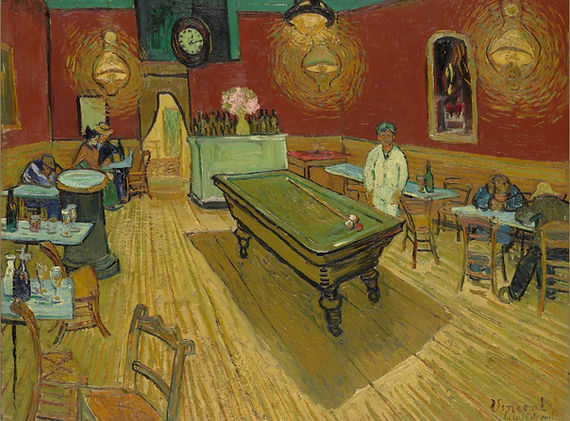
NIGHT CAFE (CAFE DE NUIT)
Vincent Van Gogh (1853-1890)
8 September 1888
Yale University Gallery, New Haven, CT, United States
Vincent Van Gogh wrote to his brother Theo (August 1888): “Today I will probably start on the interior of the inn where I’m lodging...it is what we call a cafe de nuit (they’re common here), which stays open all night. Nighttime wanderers can find a refuge – it’s an asylum – when they don’t have the means to pay for a room or are too drunk to be allowed in.” The cafe is quiet and the harsh gas lighting accentuates the sadness of the setting. Under the eye of the waiter, a couple and a few tired customers kill time, alone, long into the night. Wine and absinthe sit together on the shelf.
Van Gough added, a month later: “I wanted to show that the cafe is a place where one can destroy oneself, go mad, commit crimes. I did this by using contrasts of soft pinks, reds and crimsons; pale and Veronese greens clash with yellowish and bluish chrome greens, together producing an infernal, sulfurous atmosphere, expressing the shadowy power of an assommoir.” Van Gogh’s expressionism strongly foreshadows the artist’s eventual perdition. Several months later, he succumbed to a spell of madness and attacked Gaugin, who had come to Arles at his invitation. Almost two years later, he would commit suicide almost two years later at Auvers-sur-Oise.
19TH CENTURY

WOMEN ON THE TERRACE OF A CAFE (FEMMES A LA TERRASSE D'UN CAFÉ LE SOIR) Edgar Degas, 1877 - Musée d'Orsay, Paris / 1

AT CAFE Auguste Renoir, ca. 1877 - Kröller-Müller Museum, Otterlo, The Netherlands

AT CAFE (AU CAFÉ) Gustave Caillebotte, 1880 - Musée des Beaux-Arts, Rouen, France

AT CAFE LE BOUCHON (AU CAFÉ LE BOUCHON) - Unachieved Edouard Manet, 1878/79 - Pushkin Museum, Moscow / 4
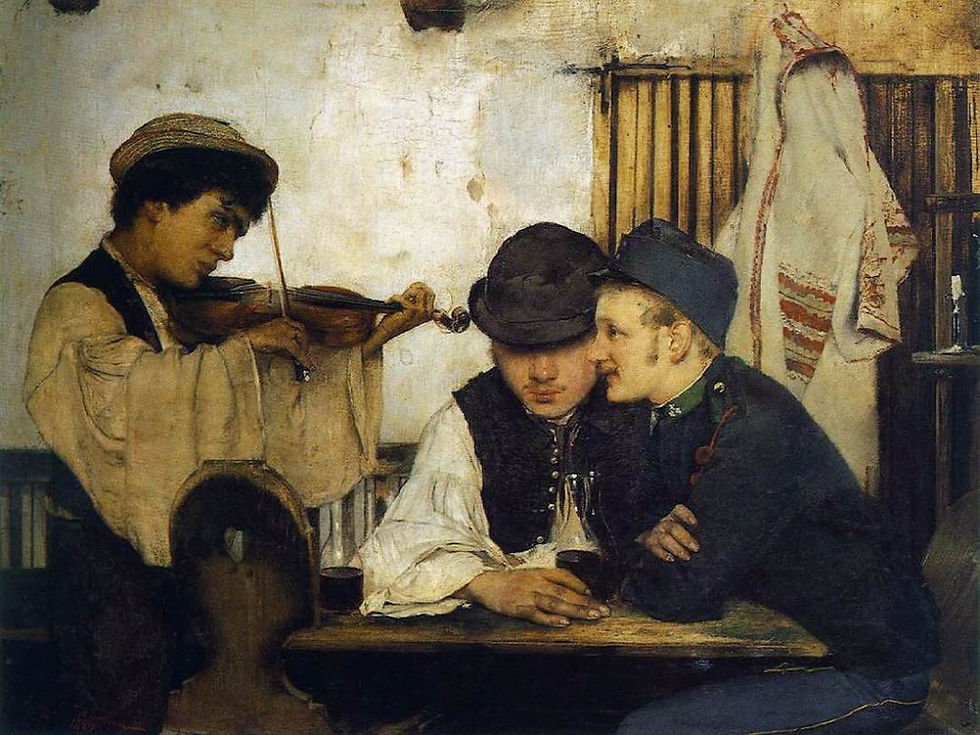
GOOD WINE Simon Hollosy, 1884 - Magyar Nemzeti Galéria, Budapest, Hungary
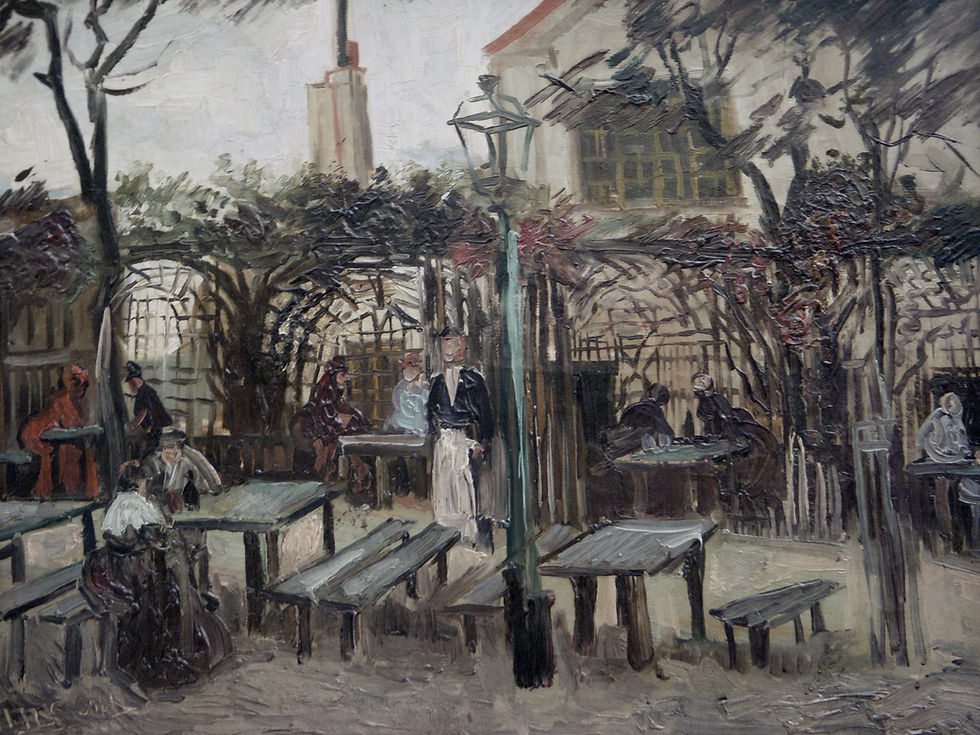
TERRACE OF A CAFE ON MONTMARTRE (LA GUINGUETTE) Vincent Van Gogh, 1886 - Musée d'Orsay, Paris

CAFE TERRACE AT NIGHT Vincent Van Gogh 16 September 1888 - Kröller-Müller Museum, Otterlo, The Netherlands

NIGHT CAFE AT ARLES, MADAME GINOUX Paul Gauguin, 1888 - Pushkin Museum, Moscow / 8

OUTSIDE FF DOORS Ramon Casas, 1890 - Museu Nacional d'Art Contemporani, Barcelona, Sapin
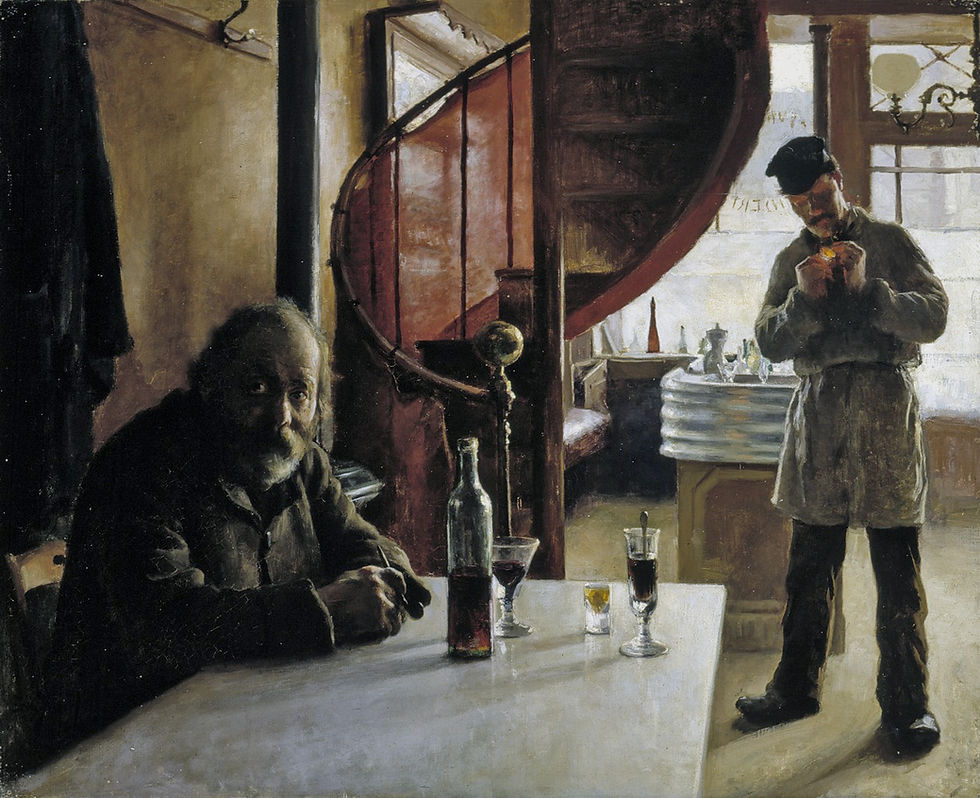
THE WINE MERCHANT LEFRANC, BOULEVARD CLICHY, PARIS Eero Järnefelt, 1888 - Athenemin Taidemuseo, Helsinki, Finland

SMOKER Paul Cézanne, 1890/92 - Hermitage Museum, St Petersburg, Russia / 11

THE DRINKER (LE BUVEUR) Paul Cezanne 1890/1900 - The Barnes Foundation, Philadelphia, PA, USA / 12
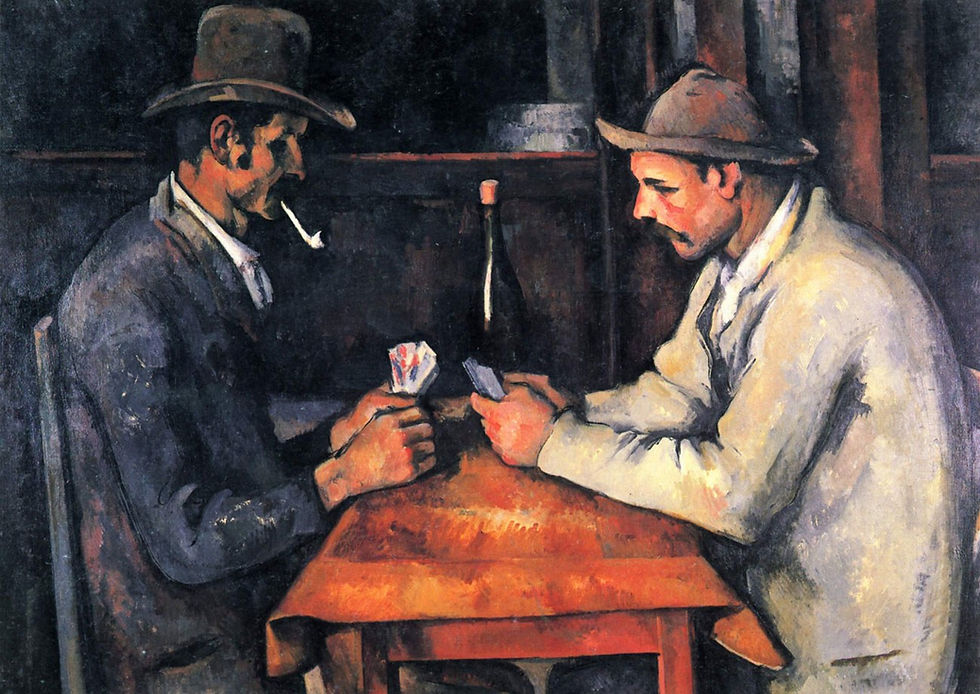
THE CARD PLAYERS (LES JOUEURS DE CARTE) Paul Cezanne, 1892/93 - Qatar's royal family / 13

THE CARD PLAYERS (LES JOUEURS DE CARTE) Paul Cezanne, 1892/95 - Musée d'Orsay, Paris / 14
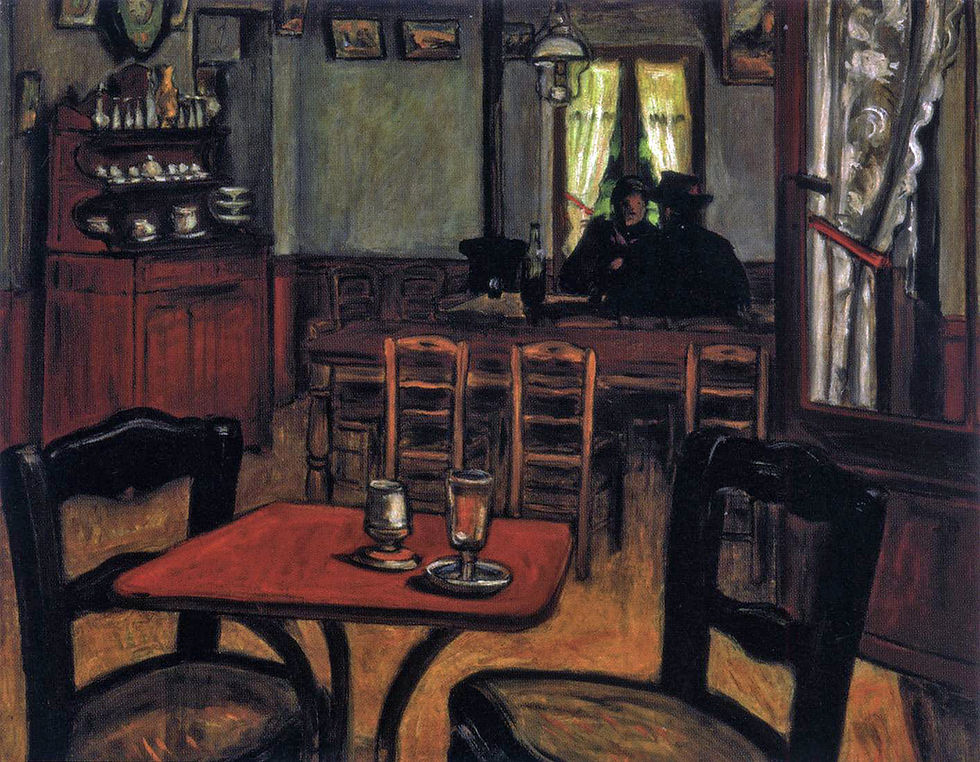
THE BIG GLASS József Rippl-Rónai, 1893 - Private Collection
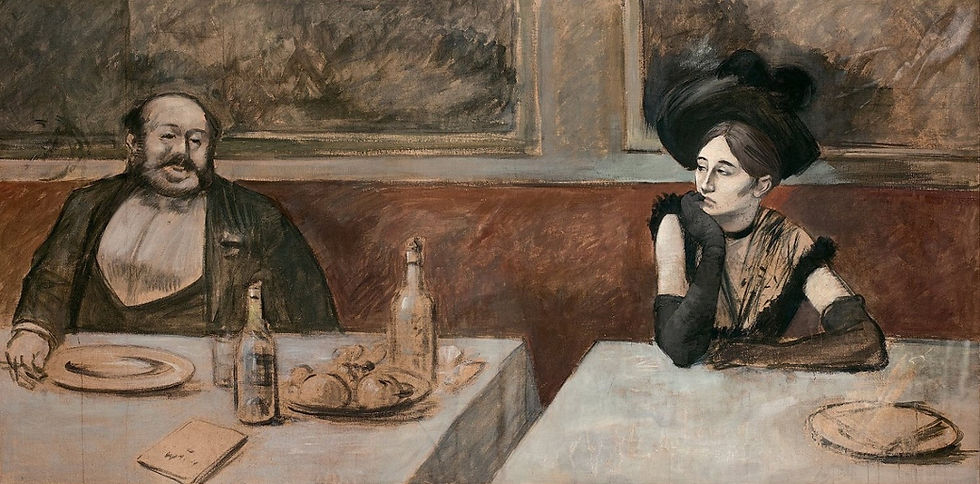
AT CAFE RICHE Jean-Louis Forain, 1894 - Private Collection / 16

HAPPY TIME (PARTIE DE PLAISIR or CAFE)) Edouard Vuillard, ca. 1898-1899 - Private collection

CAFE SCENE (SCÈNE AU CAFÉ) Edouard Vuillard, 1899 - Neue Pinakotek, Munich, Germany
> Click on the icons for a closer look at the artworks
Cafes were born in the century of the Enlightenment. In Paris, “the salons of intelligence and the twin assets of social and intellectual distinction. Wine (still or sparking champagne, Tokay or Rhine valley wine) is rarely drunk here.” Cafes were not depicted by master painters, most of whom still had little interest in genre scenes. From the second half of the 19th century, cafes became more democratic and, under many different names (cabaret, wine merchant, mastroquet), attracted people from every social and professional rank. Anyone could be found in this type of space. A place of light, warmth and sociability, the cafe became a social melting-pot. Between the cafe walls, ‘people’ could talk, play, drink and smoke, usually in a kind of sociable anonymity.
1. Cafes and cafes concerts became a central point of urban life. Once more, it was Haussmann’s Paris which gave them this importance, as the large pavements of the boulevards, glowing under gaslights at night, allowed cafés and restaurants to flourish. In his Women on the Terrace of a Cafe in the Evening (Femmes à la terrasse d’un café le soir), Degas portrays “prostitutes, wilted, faded creatures who, sweating vice, cynically go over the events of the day” (Georges Rivière).
4. For many customers, cafés provided a substitute family and a way of killing time, like the drunken woman asleep on her neighbor's shoulder in At Cafe Le Bouchon by Edouard Manet, himself a regular of all sorts of Paris cafés.
8. On the 23rd October 1888, Paul Gauguin arrived at Van Gogh’s home in Arles. Night Café at Arles, Madame Ginoux is one of Gaugin’s personal interpretations of Van Gogh’s work. We see none of the desolation apparent in Van Gogh’s version of the scene. The anonymous visitors seem to shrink behind the imposing figure of Madame Ginoux. Gaugin only dealt with the hidden side of life, preferring to paint in a way that appealed to the imagination as he also demonstrates in Grape Harvest at Arles (or Human Anguish). Paul Gaugin shows us “this [very] café that Vincent likes a lot and I somewhat less. I like it when others are there, but I still feel apprehensive. It’s a question of education and such things cannot be undone.” While Gaugin’s painting fails to show the same uninhibited expressionism as that of Van Gogh, it portrays a person sleeping and prostitutes, both typical customers of all-night cafés.
9. Dining scenes were a recurrent theme for the artists of the so-called ‘Belle Époque’. All appear to have turned their hand to cafe or restaurant scenes. Whether joyful or miserable, provocative or tipsy, full or hungry: all such slices of life have been dealt with in creative ways. Most striking among these seated couples is their air of solitude. They may be together physically, but their eyes never meet; each is in his or her own world, where the other counts for nothing or – at most – only for what they stand to benefit their partner. Here, two stories play out silently; the empty space between the tables creates a frontier. To the left, a fat, lascivious-looking man, replete from his meal, waits for his bill; to the right, the thin and hungry-looking ‘lorette’ (cheap woman) half-heartedly waits for someone to invite her to dinner. (Editor’s note: perhaps she is glowering at her neighbour)... ‘Le Riche’ was a large Boulevard cafe-restaurant. Men and women of letters, journalists and editors, painters and musicians – all sorts of bright young things frequented such places. If their evening gatherings ever took a risqué turn, there were small private salons upstairs” (Source: Beaussant Lefèvre auction catalogue).
11-12. These Cezanne’s figures give the impression of balance and tranquillity.
13-14. In Paul Cezanne’s The Card Players, to be found in the Musée d'Orsay and also in Qatar*, the bottle, on which the light is playing, becomes the central axis of the composition, separating the space into two symmetrical areas and thus highlighting the opposition of the card players. Cezanne used as models peasants whom he had seen on the Jas du Bouffan family estate, near Aix-en-Provence. The two men, in Sunday best, have not taken off their hats. They seem to be frozen and concentrated on their game. Although impossible to identify, the cafe seems to be of the most basic sort, featuring a wooden table covered with a short tablecloth, ordinary chairs, a simple bottle of wine. Only a mirror on the wall adds to the decor.
16. The dinner and the diner is a recurring theme among artists of the so-called “Belle Époque”. Whether in a café or restaurant, all have tried it. With characters joyful, miserable, provocative, drunken, full or ravenous, all have skilfully covered this slice of life. The thing that strikes us about the couple here is the feeling of solitude. They’re there together, but their eyes never meet: each is in their own world; the other doesn’t count or, if they do, it’s only because one of the characters hopes to take advantage of the other in some way. Two wordless stories unfold. A frontier is created by the empty space between the tables: to the right, the large, lusty and full-looking bourgeois gentleman is waiting for his bill, while to the left, the thin and hungry lorette [a term for young women of light morals of the time] waits, with little conviction, for someone to buy her dinner. [Editor’s note: We can easily imagine this woman casting a look of disdain at her neighbour.] … “Le Riche” was one of the great Boulevard cafés and, like all of them, also a restaurant. The literati, newspapermen, painters, musicians and other great minds met there… Nights here could take a naughty turn, with private rooms upstairs (Source: Beaussant Lefevre auction catalogue).
* Several versions of The Card Players were produced by Cezanne: five copies are conserved at the Musée d'Orsay, the Courtauld Institute of Art in London, New York’s Metropolitan Museum of Art and the Barnes Foundation in Philadelphia. As for the fifth known copy, it was bought privately by the Qatari royal family for 228 million Euros, making it the most expensive painting in 2012! A sad record, even though the work is magnificent [Editor’s note: This record has been beaten by a work of Gaugin acquired for 265 million Euros, also in Qatar, 2015. And by a work of Leonardo da Vinci acquired for 381 million Euros in 2017, acquired by Abu Dhabi’s department of culture and tourism]. This version and those of the Musée d'Orsay and the Courtauld Institute are the only three to feature wine and just two characters. The Qatar version was finished before that of the Musée d'Orsay, and is two and a half times bigger (97 x 130cm v. 47.5 x 57cm).
20TH CENTURY


EL PARALELO CAFÉ CONCERT (Barcelona, Spain) Pablo Picasso, 1900/01 - National Picasso Museum, Paris

TWO WOMEN AT A BAR (DEUX FEMMES AU BAR) Pablo Picasso, 1902 - Hiroshima Museum of Art, Japon

NOTRE-DAME, SUN Albert Marquet, 1905 - Fine Arts Museum, Pau, France

THE BAR WITH BOATERS Auguste Elisée Chabaud, ca. 1808 - Private collection

'MANILLE' PLAYERS (JOUEURS DE MANILLE) José Louis Engel Garry, bef. 1917 - Fine Arts Museum, Libourne, France

EROUSLY WOUNDED, AT CAFE (Le Faouet, Britanny, France) Marius Borgeaud, 1921 - Hermitage Foundation, Lausanne, Switzerland

AT CAFÉ Edward Hopper, 1906/07 - Whitney Museum, New York

WOMAN SEATED AT CAFÉ Edward Hopper, 1906/07 - Whitney Museum, New York

THE BISTRO or THE WINE SHOP Edward Hopper, 1909 - Whitney Museum, New York / 10
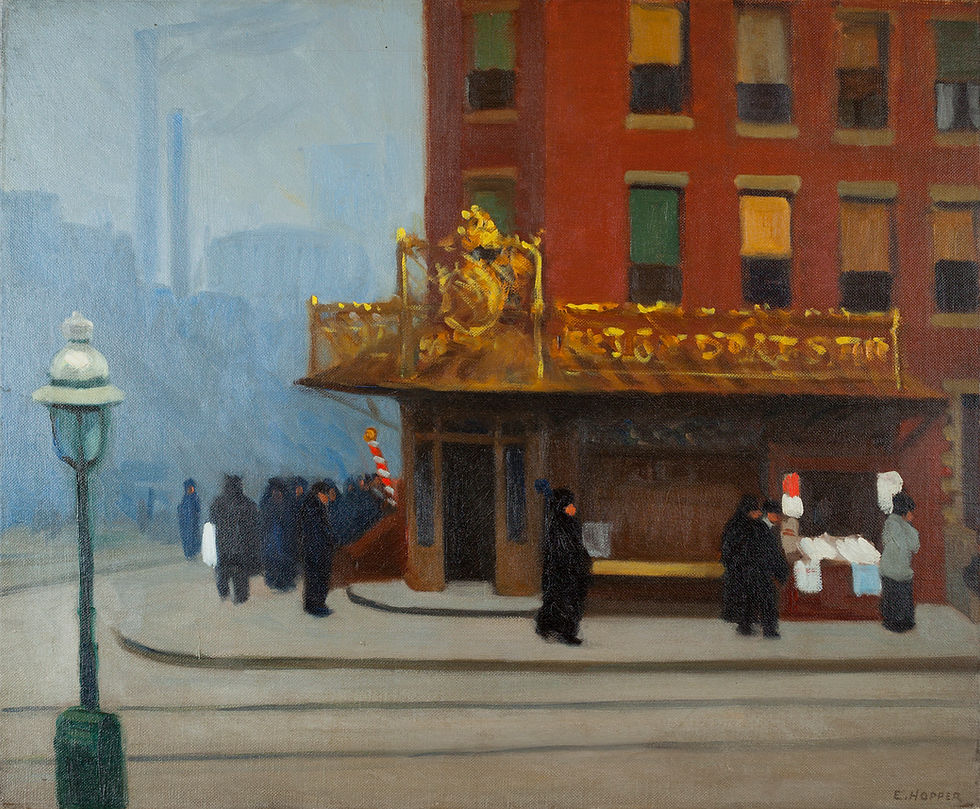
NEW YORK CORNER (SALOON CORNER) Edward Hopper 1913 - Cantors Arts Center, Stanford University, CA, United States

SOIR BLEU Edward Hopper, 1914 - Whitney Museum, New York
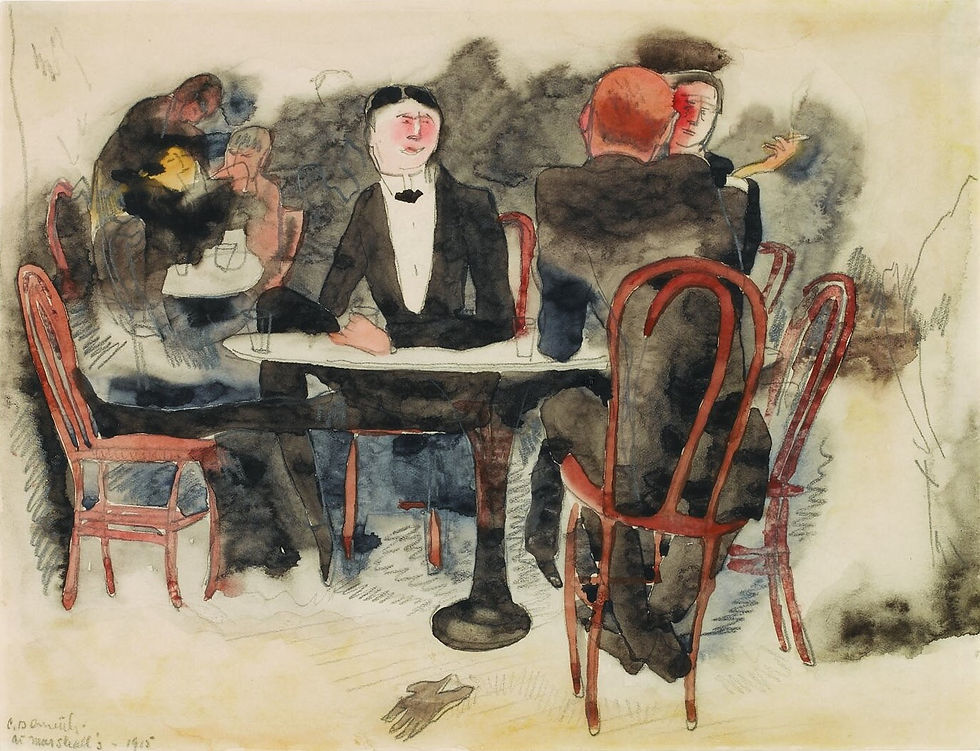
AT MARSHALL'S Charles Demuth, 1915 - Demuth Museum, Lancaster, PA, United States
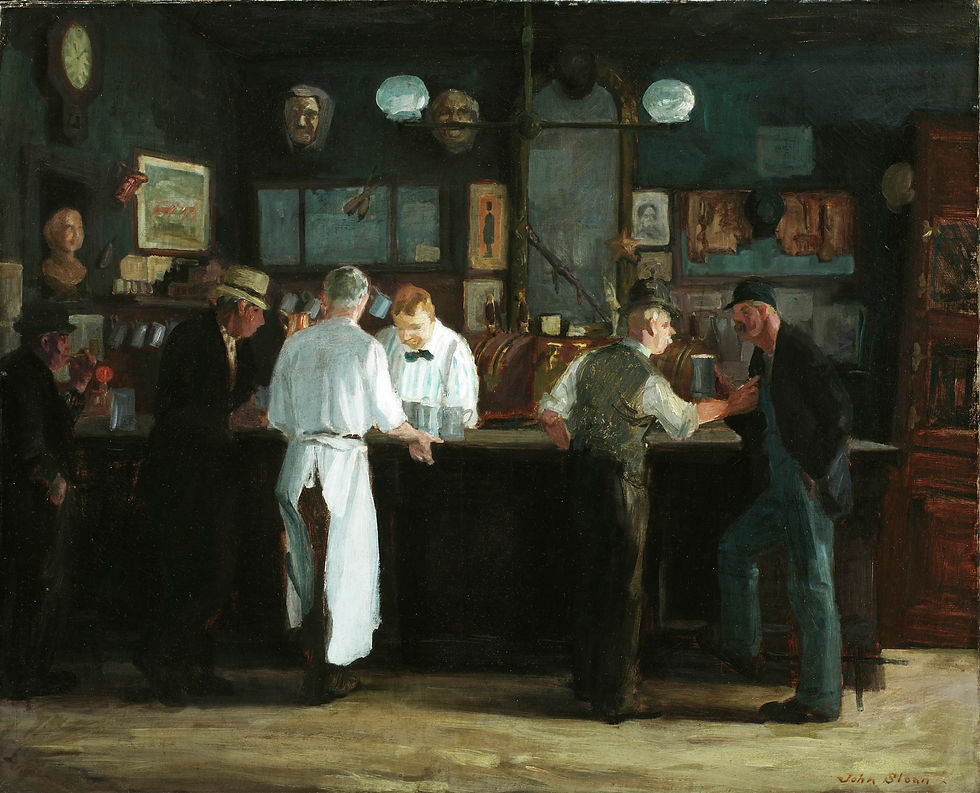
McSORLEY'S BAR John Sloan, 1912 - Detroit Institute of Arts, Detroit, MI, United States

THE CAFÉ Ossip Zadkine,1921 - Private collection / 15

THE GUITAR PLAYER (LE JOUEUR DE GUITARE) Ossip Zadkine, 1920 - Musée d'Art Moderne, Paris / 16

TWO DRINKERS LEANING ON THE BAR Ossip Zadkinen, 1922 - Museum of Modern and Contemporary Art, Strasbourg, France

THE CAFE TERRACE (LA TERRASSE) Ossip Zadkine, 1920 - Private collection

AT CAFE (AU CAFÉ) Ossip Zadkine, 1921 -Nash collection, London

MAN WITH A WINE GLASS Amedeo Modigliani, 1918 - Private collection / 20
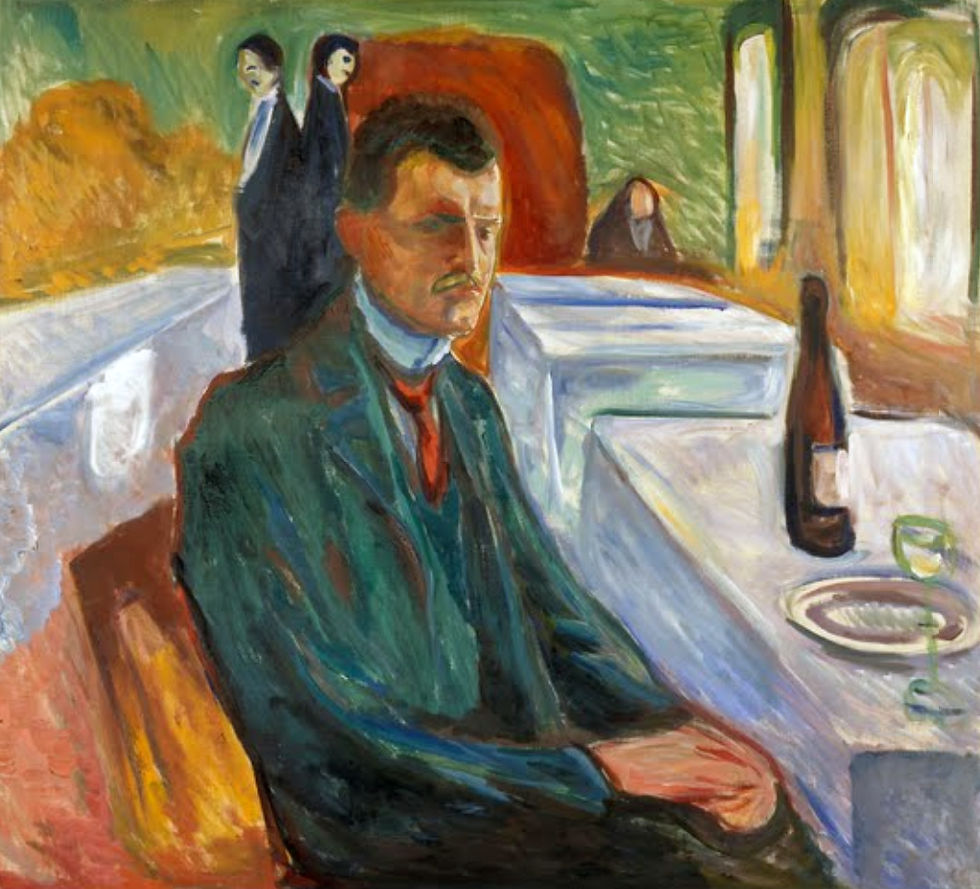
SELF-PORTRAIT WITH A BOTTLE OF WINE Edward Munch, 1906 - Munch Museum, Oslo, Norvay / 21

TAVERN Ernst Ludwig Kirchner, 1908 - Saint Louis Art Museum, MO, United States

GREEN LADY IN A GARDEN CAFE Ernst Ludwig Kirchner, 1912 - Kunstsammlung, Düusseldorf, Germany
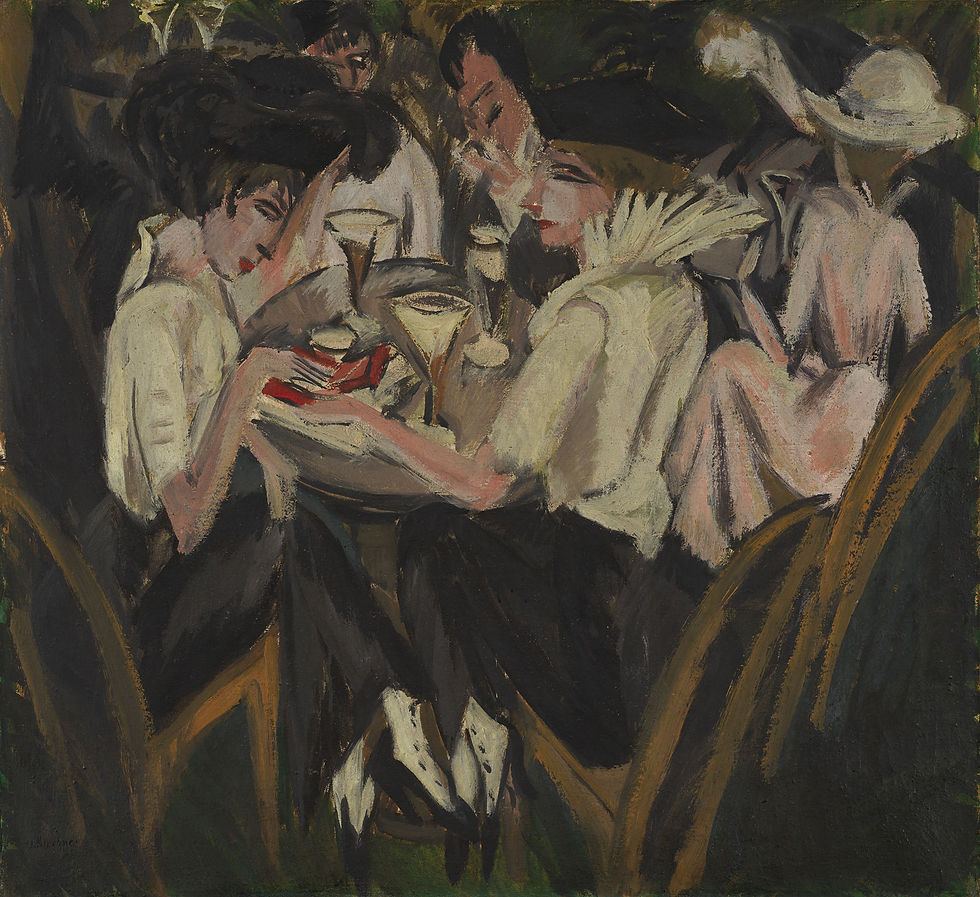
THE GARDEN CAFE Ernst Ludwig Kirchner, 1914 - Brücke-Museum, Berlin

AT THE WINE TABLE Emil Nolde, 1911 - Nolde Stiftung Seebüll, Neukirchen, Germany

WINE BAR Karl Schmidt-Rottluff, 1913 - Brücke-Museum, Berlin, Germany

CAFE, 1915 Georges Grosz, 1915 - National Museum of American History, Washington / 27

CAFÉ George Grosz, 1916 Saint Louis Art Museum (SLAM), Saint Louis, MO, United States

'GERMAN WINE AND GERMAN SONG' George Grosz, 1919 - E.W/K. Collection, Bern / Davos, Switzerland

AT CAFE George Grosz, 1922 - Private collection

SELF-PORTRAIT WITH CHAMPAGNE GLASS Max Beckmann, 1919 - Städel Museum, Francfurt, Germany

BAR, BROWN Max Beckmann 1944 - Los Angeles County Museum of Art (LACMA), United States

BANDOL CAFE Max Beckmann, 1944 - Private Collection
> Click on the icons for a closer look at the artworks
10. One of Edward Hopper’s ‘Parisian’ paintings, Le Bistro or The Wine Shop, was painted ‘from memory’ in the USA in 1909. We are on the banks of the Seine, not far from a bridge which might be the Pont-Neuf.
15. Ossip Zadkine often made reference to the cafes, particularly those of Montparnasse: doubtless these included the smoky universe of La Rotonde, a regular haunt and a place where painters, musicians and writers were known to mix. Il y retrouvait Foujita, Soutine, Max Jacob, Henry Miller... Son ami le plus proche est Modigliani avec lequel il partage les mêmes difficultés : "C'était le temps des vaches maigres pour nous deux ; on s'asseyait aux terrasses des bistrots, Modi faisait des portraits de voisins de table qu'on leur donnait pour essayer d'avoir un franc. A un certain moment, pour pouvoir vivre et aussi travailler, c'était lui, un jour, qui mendiait pour deux, le lendemain c'était moi" (Source : Zadkine, Gouaches des années 20, catalogue, Arles, 1992).
16. Zadkine always drew attention to his characters by making them much larger than the surrounding urban landscape. In The Guitar Player , if the pavement café in the foreground is animated by the guitarist and sitting customers, the road behind is deserted, gray and lined with identical-looking houses. The undetailed, pastel-hued figures are brought to the fore by the brighter colors of the setting.
20. Modigliani liked to record his friends’ faces: he had been the portrait-painter of tout-Montparnasse. Pavement cafes were a central part of his daily life, where he procured both models and the drunkenness necessary for each new burst of inspiration.
21. Edvard Munch is weak, isolated and seems indifferent or resigned. He is shown sitting at a table in a ‘claustrophobic’ yet almost-empty cafe, inhabited by two ghostlike waiters and the outline of an old woman sketched into in the background. Munch takes the same path as Van Gogh – that of Expressionism.
27. The wartime viewpoint of a painter already Dadaist, anti-bourgeois and provocative.

THE MAN AT THE CAFÉ Juan Gris, Paris winter–spring 1914 - The Metropolitan Museum of Art, New York

CUBIST COMPOSITION (WAITER IN A CAFE) Fernand Léger, 1920 - Private collection

PETIT POUCET CAFE (LE CAFÉ AU PETIT POUCET) Pierre Bonnard, 1928 - Pompidou Center, Paris

COMPOSITION Mark Rothko, 1929-1931 - Collections of Kate Rothko Prizel and Christopher Rothko
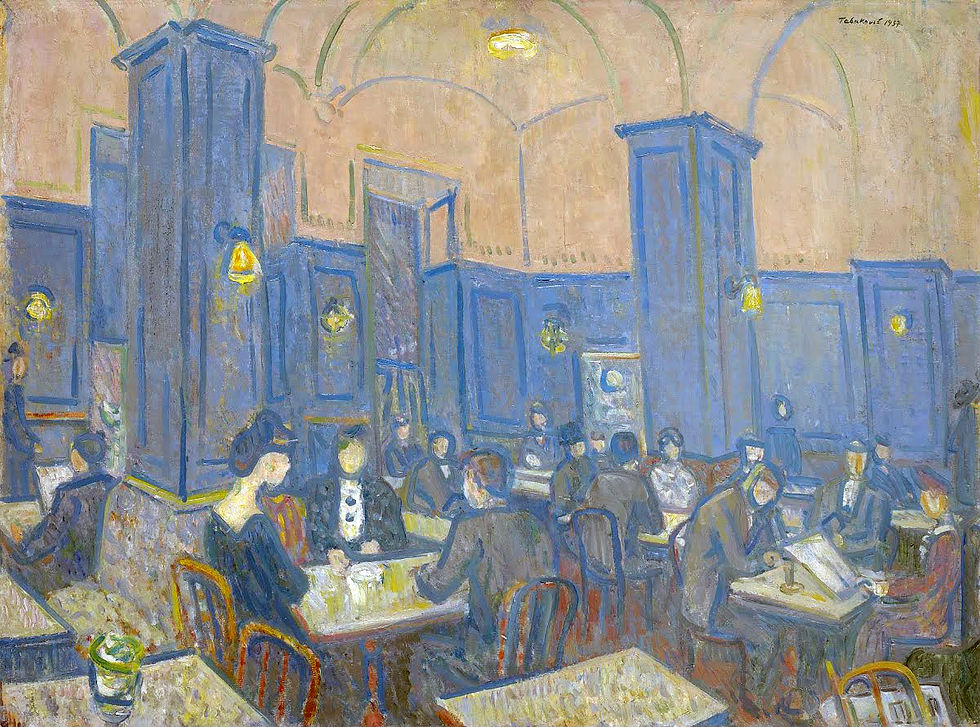
BLUE CAFÉ Ivan Tabaković, 1937 - The Pavle Beljanski Memorial Collection, Novi Sad, Serbia
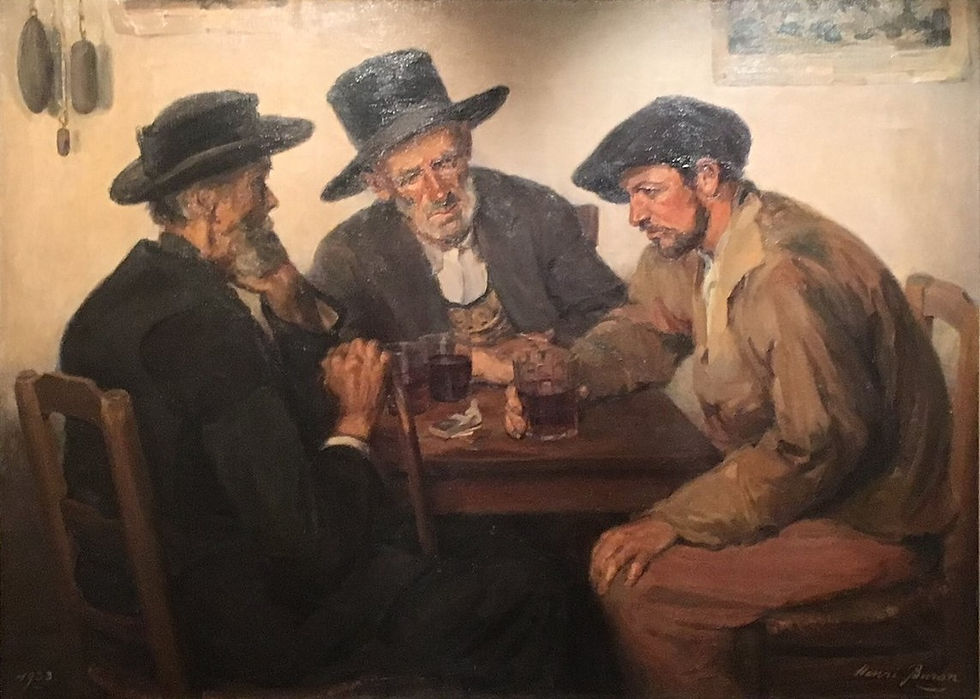
AT DRINKING ROOM Lucien-Henri Buron, 1933 - City Museum, Le Faouët, Brittany, France

CAFÉ Yasuo Kuniyoshi, 1937 - Whitney Museum, New York

WOMAN AT A CAFÉ Charles Réal, 1930s? - Fine Arts Museum, Menton, France
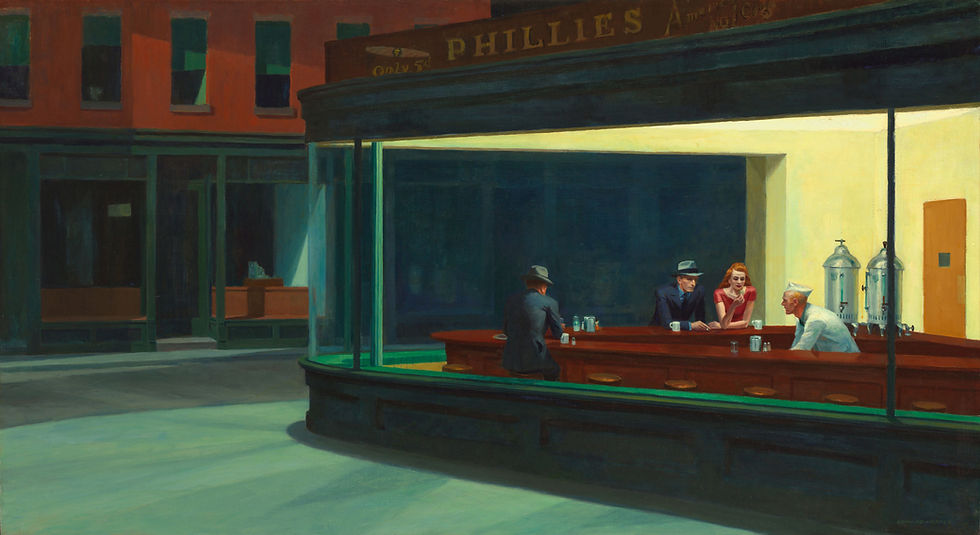
NIGHTHAWKS Edward Hopper, 1942 - Art Institute of Chicago
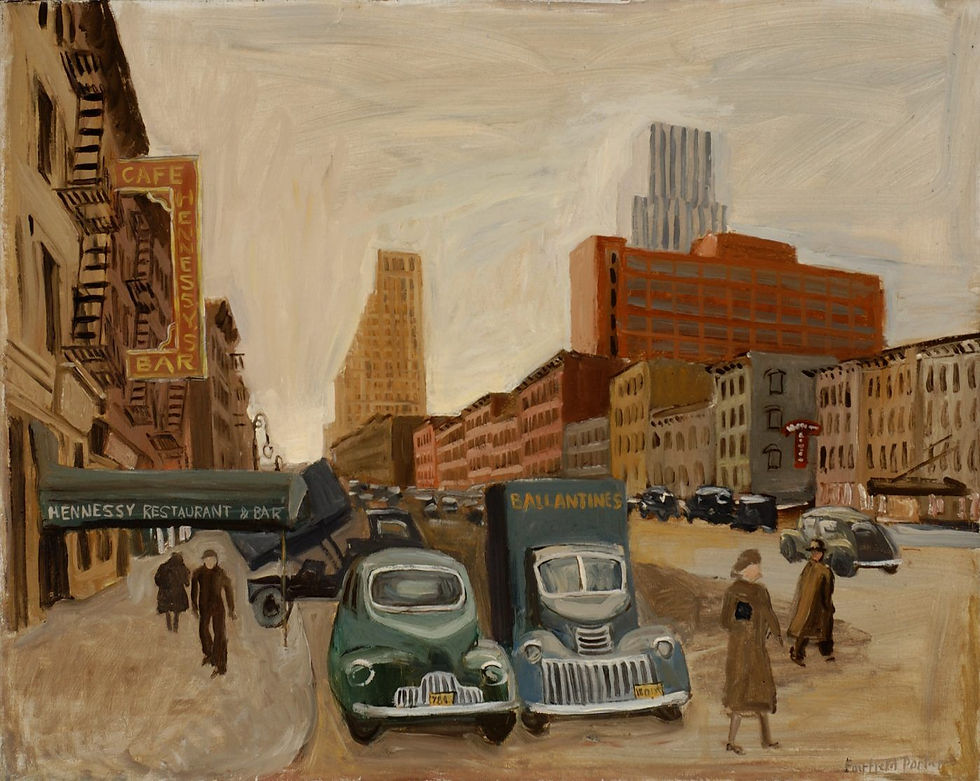
HENNESY'S BAR Fairfield Porter, ca. 1945 - Parrish Art Museum, New York
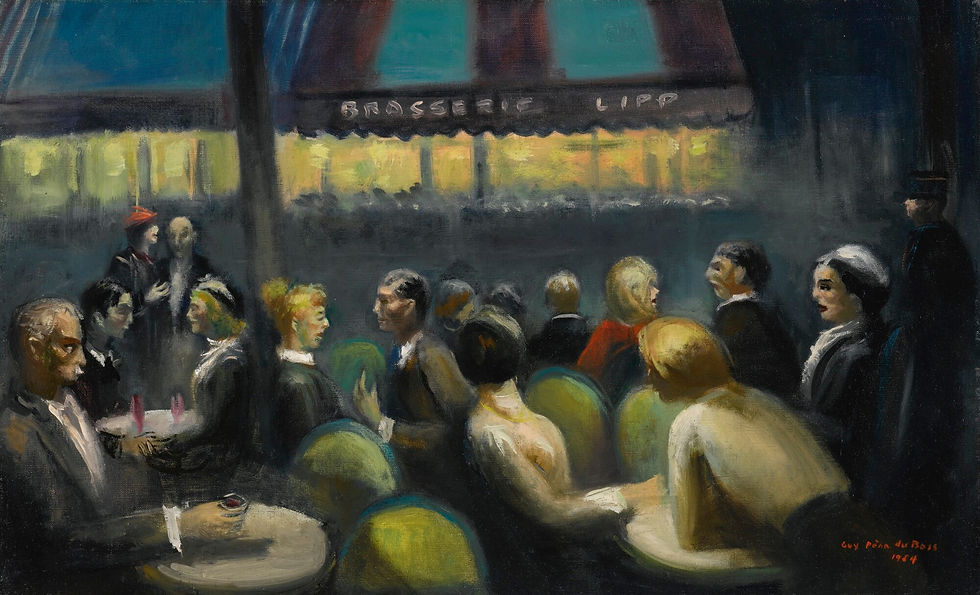
CAFÉ DE FLORE (Saint-Germain des Prés, Paris) Guy Pène du Bois, 1954 - Private collection

AT CAFE (AU CAFÉ) Léonard Foujita, 1949 - Pompidou Center, Paris

WOMAN WITH A GLASS OF WINE (FEMME AU VERRE DE VIN) Bernard Buffet, 1955 - Private collection?
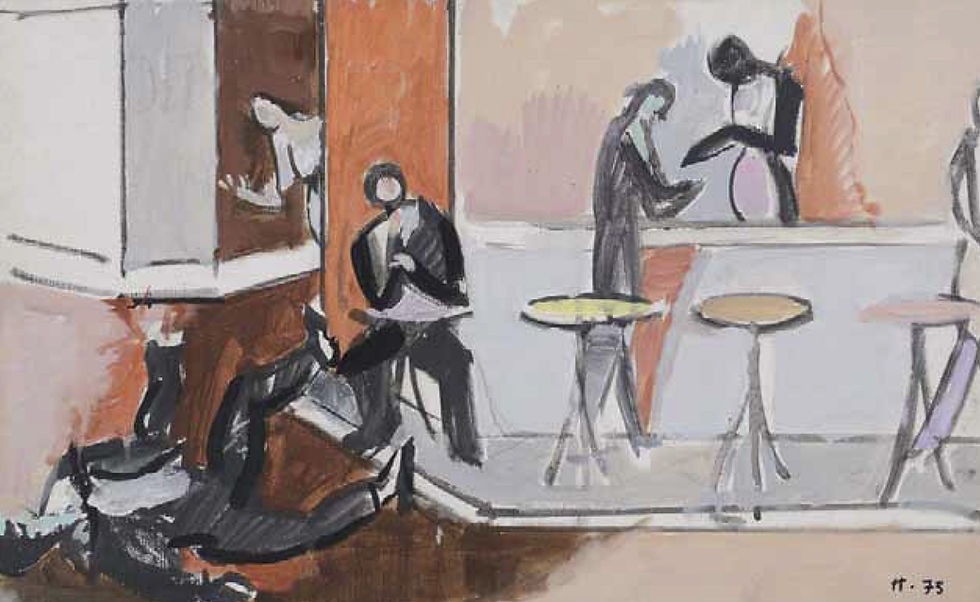
FALL IN A CAFE (CHUTE AU CAFÉ) Jean Helion, 1974 - Private collection
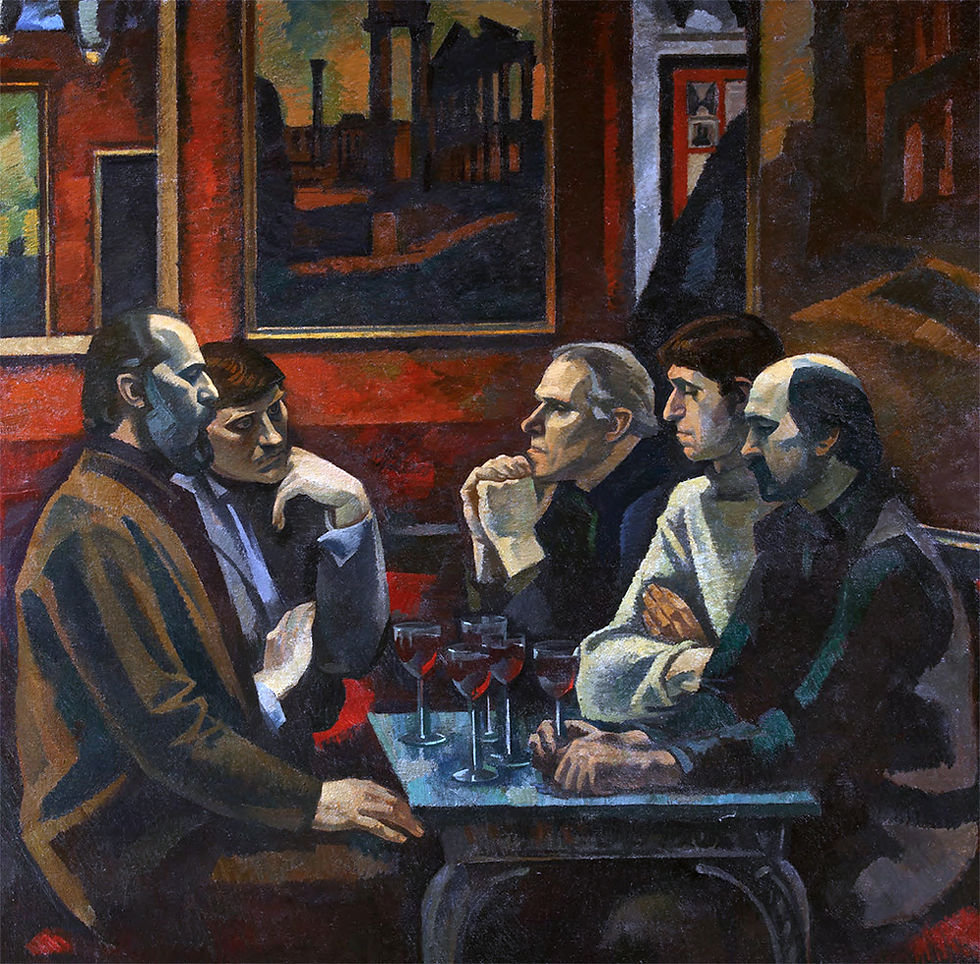
'GREKO' CAFÉ Viktor Ivanov, The Institute of Russian Realist Art (IRRA), Moscow

ANGEL GANIVET'S HOPE AND DESPAIR (ESPOIR ET DÉSESPOIR D'ANGEL GANIVET) Eduardo Arroyo, 1977 - Musée d'art moderne, Paris

DEUTSCHLAND CAFÉ Jörg Immendorff, 1980 - MoMA, New York

TWO WOMENT AT THE BAR Malcom T. Liepke, 2000 - Private collection
> Click on the icons for a closer look at the artworks
LOOKS CAN BE DECEIVING

Cet Homme dans un café de Juan Gris (1912 - Philadelphia Museum of Art), un dandy, ne boit pas du vin blanc, mais de l'absinthe ! Très alcoolisée (titrée à 70%), l'absinthe ne s'est pas contentée de faire des ravages dans les milieux populaires - dans les assommoirs** de l'époque, un verre d'absinthe côutait moins cher qu'un verre de vin -, mais aussi chez les intellectuels et la bohême d'alors. Elle sera interdite à la vente trois ans plus tard, en 1915.
Juan Gris était le seul artiste inclus dans le Salon de la Section d’Or de 1912 qui utilisait les proportions mathématiques idéales de la Section d’Or** pour construire ses compositions, comme on le voit dans le système complexe de grilles et de formes géométriques qui composent cette image.
* "Cet homme de goût moderne, avec chapeau haut de forme et costume noir, repose d’une main sur une chaise, tout en berçant un verre d’absinthe dans l’autre. L’inclusion des lettres « PIC » et « AP » à gauche de l’épaule de l’homme peut être comprise comme une référence à Picasso, le cocréateur du cubisme, et à Guillaume Apollinaire, fervent défenseur critique du mouvement" (Source : Philadelphia Museum of Art).
** L'Assommoir, roman d'Emile Zola, nom d'un débit de boissons fréquenté par le monde ouvrier.
*** "Nom donné à un groupe d'artistes qui se forma en 1911 et se rattacha au Cubisme, malgré l'absence dans ses rangs des deux créateurs de ce mouvement : Picasso et Braque. Chronologiquement, la Section d'or correspond à l'expansion de l'esthétique cubiste et représente l'effort de certains artistes d'avant-garde pour systématiser la nouvelle vision qui, chez Braque et Picasso, était intuitive. Le nom de Section d'or illustre bien les préoccupations plastiques du groupe. À la suite de l'abandon de la perspective classique dans la composition cubiste, les artistes de la Section d'or songent à répartir le nouvel espace à deux dimensions du tableau selon la " section d'or " (ou " divine proportion "), qui est le rapport idéal entre deux grandeurs. Leur but est de soumettre à la réflexion l'organisation du tableau, pour procéder méthodiquement à la réduction géométrique de la réalité" (Source : Larousse).
WINE AND THE ARTS: PHOTOGRAPHY

COMPARTMENTALIZED BISTROT, PARIS Robert Doisneau, 1950

CAFE, JOINVILLE-LE-PONT, CLOSE TO PARIS Doisneau - Pompidou Center

COCO, XAVIER PRIVAS STREET, PARIS Doisneau, 1952

'LA MÔME' BIJOU, PARIS BY NIGHT Brassai, 1933
> Click on the icons for a closer look at the artworks
The Muses’ companion, wine intersects all the arts, whether literature, music, decorative or fine arts. In any case, wine is an irreplaceable witness of our social and cultural history. Although The Virtual Wine Museum is mainly concerned with painting, some examples drawn from other artistic formats allow us to illustrate this reality, to ‘bear witness’ to it. These photographs explore the same theme as this gallery.
GALLERIES AN EVERYDAY COMPANION




